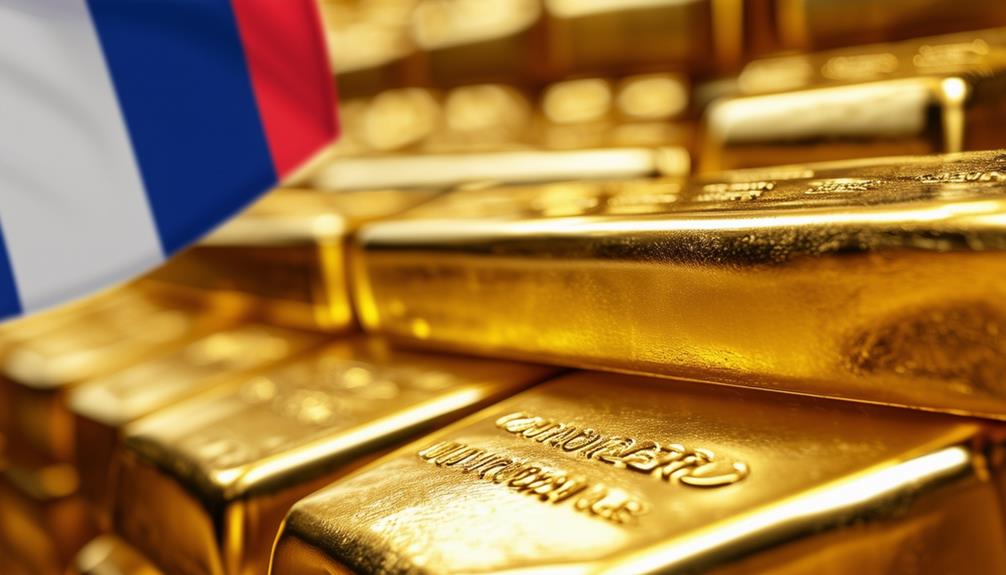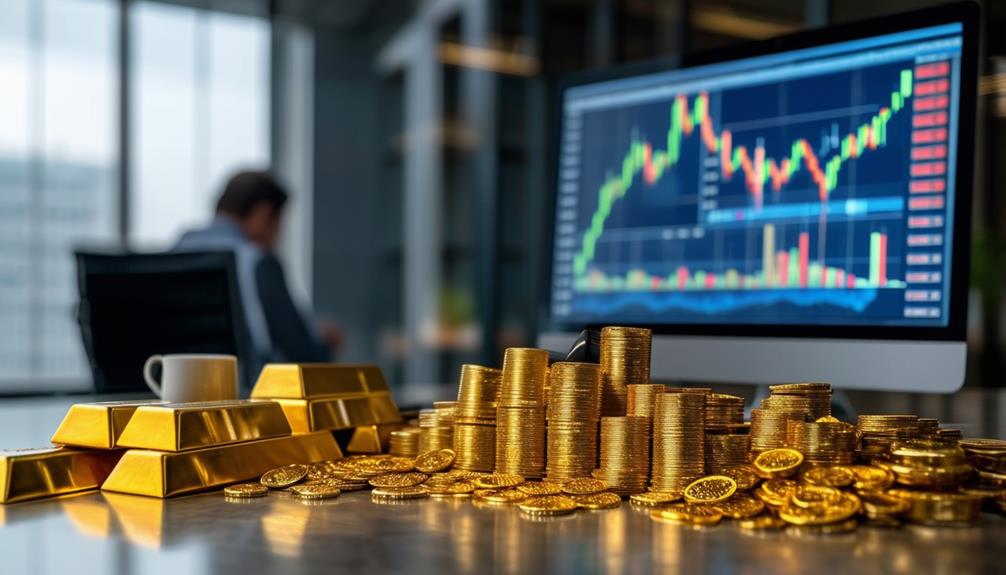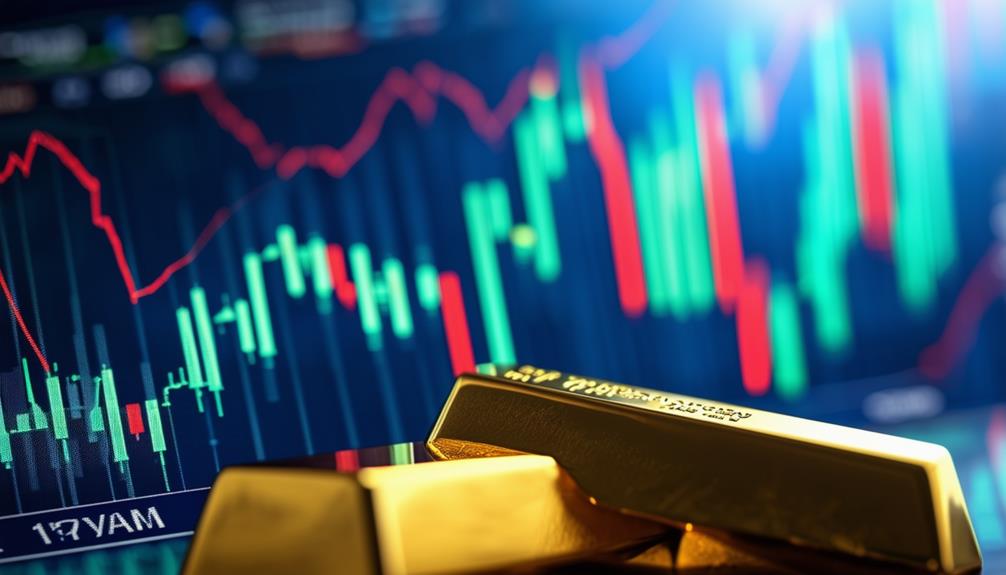To buy gold with Bitcoin securely and conveniently, begin by buying Bitcoin from a reputable exchange like Coinbase. Safeguard your Bitcoin in a digital wallet with two-step verification. Select a trusted bullion dealer that accepts Bitcoin, such as one utilizing BitPay services. Compare prices, review customer feedback, and make sure you comprehend any additional fees. During checkout, choose Bitcoin as your payment method and finalize the transaction. Monitor your order using the link provided by the dealer. Understanding market trends and tax implications is essential for ideal investment. Keep going—you’re on the path to mastering gold purchases with Bitcoin.
Benefits of Using Bitcoin

When you buy gold with Bitcoin, you’ll enjoy several key benefits. First and foremost, Bitcoin offers secure transactions. With two-factor authentication, the risk of fraud is greatly reduced, giving you peace of mind.
Additionally, the transparency of Bitcoin is unparalleled. Thanks to immutable blockchain technology, all your transactions are transparent and unalterable, ensuring complete accountability.
Furthermore, using Bitcoin can be quite cost-effective. Many gold dealers provide discounts for cryptocurrency payments, allowing you to get more value for your money. These discounts, combined with Bitcoin’s lower fees compared to credit or debit cards, mean you’ll save even more.
Fast transactions are another major perk. Cryptocurrency payments are typically quicker than traditional methods, so you can secure your gold purchase without delays. This speed is essential when you’re looking to make timely investments.
Risks and Downsides
While buying gold with Bitcoin offers numerous advantages, it’s important to be aware of the potential risks and downsides. One significant concern is Bitcoin price volatility. The value of Bitcoin can fluctuate dramatically, impacting your potential profits or losses when you buy gold. If Bitcoin’s price drops sharply after your purchase, the value of your investment could decrease.
Another issue is the irreversible nature of Bitcoin transactions. Once you’ve sent Bitcoin to a gold dealer, the transaction can’t be undone. This poses a risk of loss, especially if you mistakenly send Bitcoin to the wrong address. Always double-check addresses before confirming transactions to avoid costly errors.
Understanding market trends is also vital. Bitcoin’s market can be unpredictable, and not keeping an eye on these trends can lead to poor timing in your purchases, potentially affecting your overall investment strategy.
Lastly, while some gold dealers offer refunds if the purchased gold products don’t meet your expectations, this isn’t always the case. You need to verify the refund policies of the dealer before making a purchase to avoid any unpleasant surprises.
Buying Bitcoin

Acquiring Bitcoin can seem challenging, but it’s a simple process if you follow some important steps. First, you need to choose a reputable exchange like Coinbase or Binance to purchase Bitcoin. These platforms are trusted and user-friendly. Before you can make any purchases, you’ll have to complete the KYC (Know Your Customer) process, which involves verifying your identity. This step guarantees the transaction is secure and compliant with regulations.
Next, it’s essential to store your Bitcoin securely in a digital wallet. You can use hardware wallets like Ledger Nano S for optimal security or software wallets such as Electrum. Adding two-factor authentication (2FA) to your account provides an extra layer of protection.
Market analysis is also crucial. Monitor Bitcoin price trends and buy at an ideal time to get the best value for your money. Here’s a quick guide to help with your Bitcoin purchasing journey:
| Step | Description | Tools/Resources |
|---|---|---|
| Choose an Exchange | Select a platform like Coinbase or Binance | Coinbase, Binance |
| Complete KYC | Verify your identity | ID, Utility Bill |
| Secure Storage | Use a digital wallet, preferably hardware | Ledger Nano S, Electrum |
| Enable 2FA | Add two-factor authentication for security | Google Authenticator, Authy |
| Market Analysis | Monitor and analyze Bitcoin price trends | CoinMarketCap, TradingView |
Following these steps guarantees you can buy Bitcoin securely and confidently.
Choosing a Bullion Dealer

Selecting a trusted bullion merchant is vital when you’re interested in purchasing gold with Bitcoin. You want to ensure your investment is secure and that you’re obtaining the best possible deal. First, concentrate on discovering gold merchants that accept cryptocurrency payments using BitPay. This secure payment platform provides an additional layer of safety for your transactions.
Next, immerse yourself in customer reviews and ratings. These insights will help you assess the credibility of potential merchants. Look for consistent, positive feedback and satisfied customers. A reputable bullion merchant will have a history of reliability.
It’s also important to contemplate the range of gold products offered. Whether you’re keen on gold bars, coins, or other forms, a merchant with a diverse selection allows you to select the right investment for your requirements.
Comparing Dealer Prices

After locating a trusted bullion dealer that accepts Bitcoin, the next step is comparing dealer prices. This allows you to get the best deal possible and make sure you’re not overpaying for your gold.
Start by comparing the prices of gold products from various dealers who accept Bitcoin payments. Look for any discounts and special offers that could save you money. Make sure to also factor in shipping costs and delivery times, as these can significantly impact the overall price.
Don’t forget to check for any additional fees or hidden charges. These could include transaction fees or processing fees specific to Bitcoin payments. It’s crucial to get a full picture of the cost before making a decision.
Here’s a simple table to help you organize your price comparison:
| Dealer Name | Price per Ounce | Additional Fees |
|---|---|---|
| Dealer A | $1,800 | $25 |
| Dealer B | $1,820 | $15 |
| Dealer C | $1,790 | $30 |
| Dealer D | $1,810 | $20 |
| Dealer E | $1,805 | $10 |
Secure Your Bitcoin Wallet
Securing your Bitcoin wallet is paramount to ensuring the safety of your digital assets. To maintain robust Bitcoin wallet security, follow these essential practices.
First, use a hardware wallet like Ledger or Trezor. These devices store your Bitcoin offline, making them less susceptible to hacking attempts.
Next, enable two-factor authentication (2FA) on your Bitcoin wallet. This adds an extra layer of security, requiring not just a password but also a second form of verification.
Keep your private keys and recovery phrases confidential. Never share them with anyone and store them in a secure location.
Regularly update your wallet software. These updates often include essential security patches that protect against potential vulnerabilities.
For those who hold significant amounts of Bitcoin, consider using a multisignature wallet. This type of wallet requires multiple signatures to authorize a transaction, adding another layer of protection.
- Use a hardware wallet like Ledger or Trezor.
- Enable two-factor authentication.
- Keep your private keys and recovery phrases confidential.
- Regularly update your wallet software.
- Consider using a multisignature wallet.
Completing the Purchase
When completing your gold purchase with Bitcoin, start by selecting Bitcoin as the payment method at checkout and provide the required details. Double-check all information to guarantee accuracy and a smooth transaction.
After confirming the transaction, you can track your order status as the gold dealer processes and ships your purchase.
Choosing Payment Method
Choosing Bitcoin as your payment method is vital when you’re prepared to buy gold. By opting for Bitcoin, you gain control over a secure, decentralized way to complete your purchase. To guarantee a smooth transaction, follow these steps diligently.
First, opt for Bitcoin as your payment method during the checkout process. This decision sets the stage for a streamlined, efficient transaction.
Next, utilize a secure Bitcoin wallet to manage your funds. Security is crucial, and a dependable wallet safeguards your assets during the transaction.
Before sending payment, verify that the Bitcoin address provided by the seller is accurate. Errors here can lead to lost funds, so double-check this essential detail.
Pay close attention to the payment details, confirming the amount and address. This step prevents mistakes and ensures your transaction proceeds smoothly.
Finally, validate the transaction on the blockchain to finalize your purchase. This validation acts as a receipt and proof of your completed transaction.
- Choose Bitcoin as your payment method during checkout
- Utilize a secure Bitcoin wallet
- Verify the accuracy of the Bitcoin address
- Double-check payment details
- Validate the transaction on the blockchain
Confirming Transaction Details
Double-check every detail to guarantee a seamless gold purchase with Bitcoin. Start by reviewing the specifics of your order—quantity, price, and shipping information. Accuracy is essential here. Next, double-check the Bitcoin payment address provided by the dealer. Even a minor mistake can lead to irreversible loss of your funds.
Before you send the payment, verify the total amount of Bitcoin required for the transaction. Confirm that the exchange rate is up-to-date and reflects the current market price. This step makes sure you’re paying the correct amount in cryptocurrency.
| Detail to Confirm | Action Required |
|---|---|
| Order specifics | Review quantity, price, shipping info |
| Bitcoin payment address | Double-check for precision |
| Total Bitcoin amount | Verify against current exchange rate |
Once you’ve confirmed all details, proceed to send the Bitcoin payment. Make sure to use a secure and reliable wallet to complete the purchase securely. Double-checking and verifying each step gives you control over your transaction, ensuring a smooth and secure buying experience.
Tracking Order Status
After you’ve completed your gold purchase with Bitcoin, it’s important to keep an eye on your order status to make certain everything goes smoothly. Tracking your order status provides transparency and keeps you informed about each step of the order fulfillment process.
You’ll typically receive order status updates through the dealer’s website or via email. These updates usually encompass:
- Processing: Confirmation that your order is being prepared.
- Shipping: Notification when your gold has been dispatched.
- Estimated delivery dates: Expected arrival times for your purchase.
- Tracking order: A link or tracking number to monitor your shipment’s progress.
- Any delays or issues: Alerts if there are any disruptions in the process.
By staying vigilant with these updates, you can make certain you’re aware of any potential delays or issues that may arise. This proactive approach allows you to address any concerns promptly and maintain control over your purchase.
Regularly checking the order status guarantees a smooth and transparent buying experience. With each update, you can rest assured that your gold purchase is on track, from processing and shipping to the final delivery. This way, you can enjoy peace of mind knowing your investment is being handled with care.
Using Payment Platforms
To buy gold with Bitcoin, you can use popular payment platforms like BitPay, which many gold dealers integrate for smooth transactions. These platforms guarantee your payments are processed quickly and securely. By using them, you can confidently purchase gold, knowing your Bitcoin transactions are safe and efficient.
Popular Payment Platforms
Why go through the hassle of traditional banking when you can use popular payment platforms like BitPay to buy gold with Bitcoin? BitPay is one of the most trusted payment platforms that facilitate secure transactions, allowing you to use Bitcoin and other cryptocurrencies for buying gold. These platforms streamline the process, making it not only faster but also more cost-effective by offering discounts for using Bitcoin.
Here’s why BitPay and similar platforms are ideal for buying gold:
- Secure Transactions: Ensuring your Bitcoin transactions are safe and reliable.
- Cryptocurrency Support: Accepts various cryptocurrencies, giving you flexibility.
- Discounts: Enjoy cost savings with Bitcoin transactions.
- Real-Time Exchange Rates: Easily track exchange rates for informed decisions.
- Seamless Experience: Simplifies the buying process, putting you in control.
2. Transaction Security Measures
Ensuring the safety of your transactions is paramount when buying gold with Bitcoin through payment platforms like BitPay. It’s crucial to choose platforms that prioritize secure transactions.
One of the most effective ways to enhance transaction security is by enabling Two-factor authentication (2FA). This adds an extra layer of protection, ensuring only you can authorize payments.
Blockchain technology also plays a vital role in transaction security. By leveraging immutable transactions, blockchain ensures that once a transaction is recorded, it can’t be altered or tampered with. This level of transparency and security is unmatched, giving you peace of mind during your gold purchase.
Using payment platforms like BitPay significantly reduces the risk of fraud or unauthorized transactions. These platforms have robust fraud prevention measures in place, safeguarding your cryptocurrency from potential threats.
Additionally, cryptocurrency payments through these platforms are known for their quick transaction speeds, allowing you to complete your gold purchase efficiently.
Ensuring Transaction Security
When buying gold with Bitcoin, safeguarding your transaction is paramount. To safeguard secure Bitcoin transactions, you need to take several precautionary steps. Start by enabling two-factor authentication on your account to add an extra layer of security.
Utilize secure and encrypted wallets to store your Bitcoin, safeguarding that your funds are safe from potential breaches.
Next, verify the authenticity of the gold dealer before making any purchase. Checking their reputation and reviews can prevent scams and fraudulent activities.
Before finalizing any transaction, double-check the Bitcoin address to safeguard that you’re sending your Bitcoin to the correct recipient. A small mistake here could result in a significant loss.
Additionally, monitor the transaction on the blockchain. This allows you to confirm that the transaction is being processed and completed securely. Leveraging blockchain security helps you stay informed about the status of your Bitcoin transactions.
Here’s a quick checklist for safeguarding transaction security:
- Enable two-factor authentication.
- Use secure and encrypted wallets.
- Verify the authenticity of the gold dealer.
- Double-check the Bitcoin address.
- Monitor the transaction on the blockchain.
Financial Considerations
When purchasing gold with Bitcoin, you can take advantage of lower fees and potential discounts, but it’s crucial to take into account the tax implications of capital gains on your cryptocurrency.
Comparing prices across dealers can optimize your savings, though market volatility might impact the value of your Bitcoin.
Ensure to incorporate these financial considerations to make an informed decision.
Cost Comparison Benefits
Buying gold with Bitcoin offers compelling cost-saving benefits that can’t be ignored. When you choose to use cryptocurrency for your gold purchases, you’re tapping into multiple financial advantages that can enhance your investment strategy and control over expenses.
First, transaction fees for Bitcoin transfers are typically lower than those for credit card payments, directly reducing your costs. Many gold dealers also provide discounts for cryptocurrency transactions, which can lead to significant savings. By using Bitcoin, you bypass currency conversion fees that would otherwise eat into your funds when dealing with foreign currencies.
Here’s a quick overview of the cost benefits:
- Lower transaction fees compared to credit card payments.
- Dealer discounts for using cryptocurrency.
- No currency conversion fees, saving you money.
- Immediate cost savings over traditional payment methods.
- Potential tax implications for capital gains.
Tax Implications Overview
While the cost-saving advantages of buying gold with Bitcoin are impressive, it’s also important to factor in the tax implications that come with such transactions. When you use Bitcoin to purchase gold, you might face capital gains taxes under most tax jurisdictions. These taxes are assessed based on the increase in value of your Bitcoin from the time you acquired it to the time you used it to buy gold.
Additionally, when you eventually decide on selling gold that was purchased with Bitcoin, any profits you make will also be subject to taxation. This makes understanding the tax laws surrounding cryptocurrency transactions essential for your financial planning. Properly accounting for these tax implications will help you avoid unexpected liabilities and ensure compliance with tax regulations.
To navigate this complex area, consulting with a tax professional is highly recommended. They can provide insights tailored to your situation, assisting you in integrating these considerations into your overall financial strategy. By doing so, you’ll maintain control over your investments and guarantee that your transactions are both profitable and compliant.
Market Volatility Impact
Exploring the world of cryptocurrency and precious metals requires a keen eye on market volatility. When purchasing gold with Bitcoin, you must consider Bitcoin price fluctuations, as it can impact your potential profits. The value of Bitcoin can fluctuate wildly, leading to uncertainties in the value of the gold you purchase.
To navigate these waters effectively, maintaining market awareness is essential. You need to be mindful of:
- Possible risks associated with Bitcoin’s market volatility.
- Financial consequences of these fluctuations on your investment.
- Uncertainties that come with using a highly volatile currency.
- Value changes that could affect the amount of gold you can buy.
- Cost efficiency of your purchase strategy.
Understanding these factors will help you make informed decisions. If Bitcoin’s value drops dramatically after you buy gold, you might find that the cost efficiency of your purchase diminishes.
Conversely, if Bitcoin’s value rises, your investment could be more profitable. Thus, keeping an eye on the market and being aware of potential risks can help you mitigate uncertainties and manage your financial implications better. This strategic approach will give you the control needed to navigate the complex landscape of purchasing gold with Bitcoin.
Tax Implications
When you decide to buy gold with Bitcoin, it’s essential to understand the tax implications involved. Selling Bitcoin to purchase gold typically triggers a taxable event. The capital gains on your Bitcoin, which is the increase in value from when you acquired it to when you sold it, need to be reported. This means that any profit you made from the appreciation of your Bitcoin is subject to taxation.
Once you’ve acquired gold purchased with Bitcoin, its value may also appreciate. Keep in mind that this appreciation is also subject to taxes.
To navigate these complexities, it’s advisable to consult a tax professional. They can provide tailored advice on reporting gains and help make sure you’re compliant with all tax regulations.
Maintaining accurate records of your transactions is essential. Record the date, amount, and value of both your Bitcoin and gold transactions. This documentation will be invaluable when you’re reporting gains to tax authorities.
Investment Strategies
Balancing your investment portfolio by integrating gold and silver purchases with Bitcoin can offer a unique blend of stability and dynamism. To enhance your investment strategies, you need to assess several key factors that enable you to take control and make well-informed decisions.
Start with a thorough market analysis. Understanding market trends and emerging opportunities helps you stay ahead and make strategic moves. Diversification is vital. By spreading your investments across gold, silver, and Bitcoin, you balance the stability of precious metals with the dynamic nature of cryptocurrencies, mitigating risks.
Here are some actionable steps to ponder:
- Set Clear Investment Objectives: Know your long-term goals and investment horizon.
- Monitor Market Trends: Stay updated on market movements to identify optimal buying and selling points.
- Balance Your Portfolio: Allocate your investments to achieve a mix that aligns with your risk tolerance.
- Evaluate Performance Regularly: Review how each asset is performing and adjust as necessary.
- Stay Informed: Keep yourself educated about the latest developments in both precious metals and cryptocurrencies.
Security and Privacy
Security and privacy are paramount when purchasing gold with Bitcoin. You want to guarantee that your transactions are secure and your identity is protected throughout the process. Bitcoin transactions are secured through cryptographic encryption and decentralized blockchain technology, providing a strong shield against fraud and hacking attempts.
When dealing with Bitcoin, your private keys are essential. They safeguard the privacy of your Bitcoin transactions, making them pseudonymous. This means that while your transactions are publicly recorded on the blockchain, your identity remains hidden.
To maintain control over your funds, focus on wallet security. Your wallet stores Bitcoin securely with encrypted keys, protecting your assets from unauthorized access.
The decentralized nature of Bitcoin transactions further enhances security by eliminating the need for intermediaries, thereby reducing the risks associated with centralized systems. Additionally, transactions on the Bitcoin network are irreversible, adding another layer of protection by preventing chargebacks and ensuring that once a payment is made, it can’t be undone.
Alternative Cryptocurrencies
When buying gold, you’re not limited to just Bitcoin; you can also use popular alternatives like Ethereum, Bitcoin Cash, and Litecoin. Some gold dealers even accept Dogecoin, making the payment process flexible and convenient. Using a range of cryptocurrencies not only offers security but also lets you diversify your digital assets into tangible wealth.
Popular Crypto Alternatives
While Bitcoin remains the most recognized cryptocurrency for purchasing gold, several popular alternatives are worth considering. Using alternative cryptocurrencies like Ethereum, Bitcoin Cash, Litecoin, and Dogecoin can offer unique advantages and help you diversify your digital asset portfolio. These alternatives come with their own features, making them viable options for buying precious metals.
Choosing the right alternative cryptocurrency depends on various factors including transaction speed, fees, and your personal preferences. Here are some popular options:
- Ethereum: Known for its smart contract capabilities, Ethereum offers faster transaction speeds compared to Bitcoin and is widely accepted by many vendors.
- Bitcoin Cash: This cryptocurrency is a fork of Bitcoin with larger block sizes, enabling quicker and cheaper transactions.
- Litecoin: Often referred to as the silver to Bitcoin’s gold, Litecoin provides faster block generation times and lower transaction fees.
- Dogecoin: Initially started as a joke, Dogecoin has gained a massive following and is known for its low transaction costs and quick confirmations.
- Diversify: Using a mix of these cryptocurrencies can spread your risk and potentially enhance your purchasing power when buying gold.
Payment Process Overview
Curious about how the payment process works when using alternative cryptocurrencies to buy gold? It’s simpler than you might think. Many precious metal dealers in the crypto market accept cryptocurrency beyond Bitcoin, including Ethereum (ETH), Litecoin (LTC), and Bitcoin Cash (BCH). These digital currencies offer you more payment options, giving you greater control over your investments.
To get started, follow this step by step guide. First, find a reputable dealer that accepts your preferred cryptocurrency. Once you’ve selected your gold products, proceed to checkout and choose the alternative cryptocurrency as your payment option. The dealer will provide a wallet address for you to send your digital currency to.
Next, initiate an online payment from your crypto wallet. Enter the dealer’s wallet address and the exact amount of cryptocurrency required. Double-check all details to avoid any mistakes, as transactions are irreversible. Once confirmed, send the payment.
The process of buying gold with alternative cryptocurrencies is similar to using Bitcoin for gold. By diversifying your payment methods, you also diversify your cryptocurrency holdings, ensuring a more robust investment strategy. With these steps, buying gold with digital currencies is both easy and secure.
Security Considerations
Diving into the world of alternative cryptocurrencies for buying gold requires a strong focus on security. When you use cryptocurrencies like Ethereum (ETH), Bitcoin Cash (BCH), Litecoin (LTC), and Dogecoin (DOGE) to purchase gold, it’s essential to prioritize the enhanced security these options offer. Security aspects should be at the forefront of every transaction to protect your assets and personal information.
Alternative cryptocurrencies provide several benefits:
- Enhanced security: Many alternative cryptocurrencies come with advanced encryption and security features that safeguard your transactions.
- Reduced transaction costs: Using these cryptocurrencies can lower the fees associated with buying gold compared to traditional payment methods.
- Store of value: Cryptocurrencies like ETH and LTC are recognized for their stability, making them reliable stores of value.
- Diversify their portfolios: By using different cryptocurrencies for payment, you can diversify your holdings and reduce risk.
- Flexible payment options: Various gold dealers accept multiple cryptocurrencies, giving you more flexibility and control over your transactions.
Frequently Asked Questions
How Do I Buy Gold With Bitcoin?
To buy gold with Bitcoin, find a reputable dealer that accepts it. Add your gold to the cart, proceed to checkout, and select Bitcoin as the payment option. Follow the instructions, and you’ll secure your gold purchase efficiently.
How to Buy Gold for Beginners?
Start by researching reputable gold dealers and understanding the different types of gold available. Open a secure Bitcoin wallet, purchase Bitcoin, and select your gold product. Verify all transaction details carefully and monitor the delivery process.
What Is the Best Way to Buy Bitcoin as a Beginner?
Start by using popular exchanges like Coinbase or Binance. Verify your identity and set up a secure wallet. Begin with small investments to minimize risks. Explore different buying options and stay informed about market trends for better decisions.
Is It Better to Invest in Gold or Bitcoin?
You should consider your risk tolerance and investment goals. Gold offers stability and a long history of value, while Bitcoin provides high growth potential but greater volatility. Diversify your portfolio to balance both assets’ unique benefits.
Conclusion
To wrap up, buying gold with Bitcoin can be a savvy investment move if you’re well-prepared. Understand the benefits and risks, buy Bitcoin securely, and choose a reputable bullion dealer. Don’t forget to compare prices and consider tax implications. Craft a solid investment strategy while prioritizing security and privacy. If Bitcoin isn’t your preference, explore alternative cryptocurrencies. By following these steps, you’ll navigate the process smoothly and make informed decisions with confidence.




















